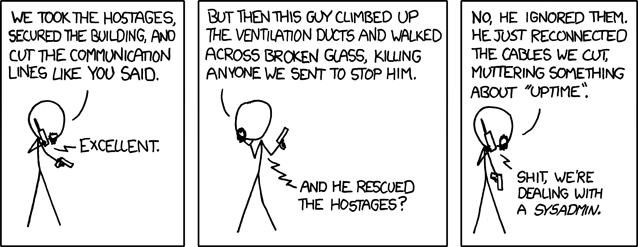 Your computer screen isn't big enough to do justice to the massive images the Hubble Space Telescope has been sending back. So check out the new film Hubble 3-D, with exclusive Imax spacewalk footage. We've got some high-res images below.
Your computer screen isn't big enough to do justice to the massive images the Hubble Space Telescope has been sending back. So check out the new film Hubble 3-D, with exclusive Imax spacewalk footage. We've got some high-res images below.
Leonardo DiCaprio narrates this documentary about the Hubble Space Telescope, which hits Imax theaters on March 19. Not only does it feature massive versions of some of your favorite Hubble space pics, it also includes some amazing Imax footage of last year's mission to repair the telescope. According to the Imax press release:
In May 2009, the crew of the Space Shuttle Atlantis launched a mission to make vital repairs and upgrades to the Hubble Space Telescope, the world's first space-based observatory, 350 miles above the Earth. On board was an IMAX 3D camera, operated by the shuttle astronauts. It captured stunning sequences of the five intricate spacewalks required to make those repairs, as well as close-up images of the effort to grasp the orbiting telescope with the shuttle's mechanical arm at 17,500 mph, and one unexpected problem that threatened to sabotage the entire mission.
'Hubble 3D' combines this breathtaking IMAX footage with images taken by the telescope during the nearly 20 years it has been our window into space. Through advanced computer visualization, Hubble's detailed data becomes a series of scientifically realistic flights that unfold on screen like a guided tour of the universe, through time and space.
Producer/director Toni Myers, who previously guided IMAX audiences into orbit with the acclaimed 'Space Station 3D,' says, 'Astronauts we've worked with have described our footage as ‘the next best thing to being there.''


 The press release explains that the Hubble mission that the Imax cameras documented was fraught with challenges:
The press release explains that the Hubble mission that the Imax cameras documented was fraught with challenges:
STS-125, the mission documented in 'Hubble 3D,' nearly didn't happen. Originally scheduled for 2006, it was cancelled due to safety concerns following the tragic crash of the Space Shuttle Columbia in February 2003. Despite support from the public and the scientific community, as well as within NASA, it simply didn't seem worth the risk-that is, until a contingency plan was proposed. NASA would prepare a second standby shuttle as a rescue
vehicle, to connect with Atlantis in space and collect its crew should there be a problem.With this precaution in place, in May 2009 the Space Shuttle Atlantis flew up to meet Hubble. Its seven-member crew was led by Commander Scott D. Altman, marking his fourth venture into space. Alongside him was pilot Gregory C. Johnson, on his inaugural flight. Mission Specialist K. Megan McArthur, also on her inaugural flight, operated the shuttle's mechanical arm to grapple and secure the telescope inside the shuttle's payload bay
where it could be reached by the repair teams.Two pairs of astronauts took turns on five separate EVAs (extra-vehicular activities), suspended in space outside the shuttle to work on the telescope. Mission Specialist John M. Grunsfeld, a veteran of five space flights, was paired with Mission Specialist Andrew J. Feustel, marking his first; and first-time spacewalker Mission Specialist Michael T. Good partnered with Mission Specialist Michael J. Massimino, who had flown twice before.
Throughout training and up to the moments before lift-off, Commander Altman reviewed the possibilities. He recalls, 'I'd go through the mission in my mind. ‘What could go wrong? Are we ready to handle it?' Hubble has a tendency to throw you a curve. We had to imagine all the things that could happen, pre-flight, and come up with solutions.'
'It's risky, but worth it,' adds Johnson. 'There were a tremendous number of people all around the world wanting Hubble back ‘alive' and it was our job to do that. It was a big mission. Every second was planned for success.' The accomplishments of STS-125 would determine Hubble's immediate future: as either an increasingly valuable scientific tool or a mute and useless piece of orbiting detritus.The mission objectives included upgrades to the telescope's Wide Field Camera and its Cosmic Origins Spectrograph, plus repairs to the Advanced Survey Camera and Imaging Spectrograph, making Hubble's vision deeper, clearer and more sensitive to color and light. They also made general repairs, replacing batteries and insulation, installing six new
gyroscopes and fixing an instrument that controls the flow of data, recently damaged due to an electrical problem.Grunsfeld describes some of what audiences will see of the EVA work. 'Generally one person rides on the end of the robotic arm which allows him to hold heavy objects, and the other person is the free floater, a little bit more mobile to do some of the other tasks, quickly, while the telescope rotates inside the shuttle's payload bay.' Every stage of the spacewalking protocol was choreographed and practiced down to the last motion. In a situation where bumping into something could fatally damage an astronaut's protective suit and fumbling a tool could mean watching it drift away into eternity, any wrong move could result in a devastating loss. The crew rehearsed extensively in the two
years prior to launch, mostly underwater in the world's largest indoor pool at NASA's Neutral Buoyancy Lab (NBL) at the Johnson Space Center in Houston, Texas. Even so, Altman's prediction about Hubble throwing them a curve came true.First, Grunsfeld and Feustel encountered a stuck bolt while trying to install the Wide Field camera on day five. It took some time and tense moments, but they finally managed to free it. The crew breathed a collective sigh of relief, but there was worse to come. On day seven, Massimino and Good were charged with replacing an obsolete piece of equipment with a highly advanced instrument designed to analyze, among other things, the atmosphere of distant planets. The hard part should have been the intricate work inside, but what proved problematic was a stripped bolt on the handle of the plate protecting it.
Massimino recounts, 'We practiced so much for that task, over and over, obsessing over every detail. The easiest bolts to remove were the four on top. And in training, zip, zip, zip, they came right out. But there we were and this one was not coming out. It was a nightmare; the world was going by, the unthinkable happened and I couldn't go to the hardware store.'
Though making light of it afterwards, Massimino's concern about the glitch and its potential repercussions is undeniable. 'It's funny what goes through your mind,' he admits. 'I was thinking, ‘This is terrible. They're going to write textbooks about this and, instead of Hubble's discoveries, it's going to say: if it wasn't for Mike Massimino we'd know if there was life on other planets.''
After hours of anxious work, much discussion among the crew and input from Mission Control, the best solution was the simplest, albeit the most counter-intuitive: break it off. Says Feustel, 'Breaking the handle off wasn't part of the plan; it's just not normal. In fact, I gave Massimino specific instructions not to break anything,' he jokes. The handle situation finally solved, the astronauts then wrapped up their repairs and celebrated the triumphant re-launch of the Hubble Space Telescope into orbit.
'There were many exhilarating moments caught on film, and certainly one of the best was when they released Hubble back into space,' Myers cites. 'This is an amazing crew. They succeeded on such a difficult mission, attempting things that had never been done in space before, beyond even what the planners thought they could achieve. To see them nail it, day after day, and to share a little in that sense of achievement, was very special.'
Expressing the sentiments of her colleagues, McArthur says, 'It's a tremendous feeling. It means so much to all of us, to be able to make a small contribution to the body of information we have about our universe.'
"






 "
"



 I learned the Josh Christ fact twice in one week, from both Ed Brubaker and Christopher Moore. Seemed like a sign to make a comic about it. - - There might be something blasphemous about running religion comics on Sundays, but man, I love 'em."
I learned the Josh Christ fact twice in one week, from both Ed Brubaker and Christopher Moore. Seemed like a sign to make a comic about it. - - There might be something blasphemous about running religion comics on Sundays, but man, I love 'em."







 "
"


